Interview with Chef John Besh at Restaurant August in New Orleans
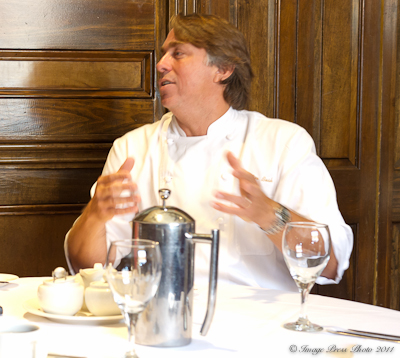
“We need to live for something bigger than ourselves and we have to love it”.
Passion. It is what great chefs have that inspires them in the kitchen. Extraordinary passion and a genuine love for a place and its people is what I found when we were with Chef John Besh at his Restaurant August in New Orleans just a few months ago.
John Besh gets very excited when talking about the food and cuisine of his region and how it impacts almost everything in his life, both personally and professionally. We wanted to learn more about where this passion is heading, rather than where it has been.
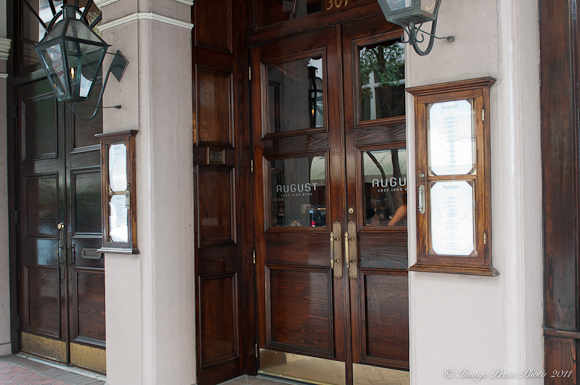
The entrance to Restaurant August
Restaurant August has always been John Besh’s dream restaurant. August’s menu is a combination of contemporary French food using local ingredients. We discussed the increasing focus on eating local foods in our country; even the small town diners now talk about where their food comes from. Said Besh, “It’s about time. It is good to see that it is catching on because it has taken awhile. The movement started with Alice Waters on the West Coast and Larry Forgione on the East Coast and is now making its way into the small town American lexicon.”
“In the 80’s and 90’s, we chefs flew everything in from around the world. We were distracted from cooking what we were familiar with. We have now matured enough culinarily in this country to where we can truly appreciate the regions, especially in the South. The growing seasons and conditions are perfect for it and are right for the new wave of chefs hailing from the South.
“We eat food that comes from a place that pays hommage to where you are. It’s not about a trend. You can make a gumbo and use what you have. Recipes don’t have to be stringent. Use what is at your fingertips. That’s where American food is headed.”
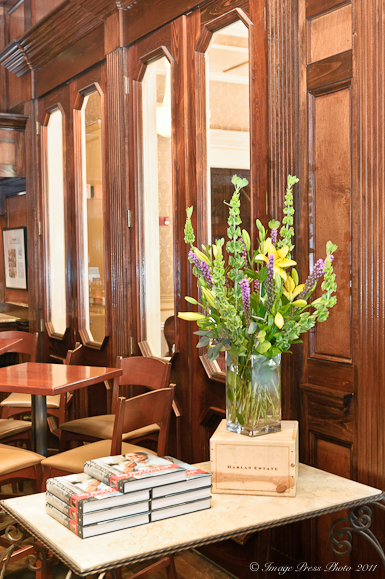
When Besh was growing up in New Orleans, all the great restaurants had European chefs. The food in New Orleans has always been a fusion of various cultures and cuisines from the peoples that had settled in the region: Africans, Haitians, French, Germans, Spanish, Caribbeans and Italians. There is also now a large Vietnamese population. The food is evolving with a new perspective. “Now we are creating our own great chefs that are cooking with a consciousness of a place.”
One of the ways that Besh is trying to help foster and support some of the young chefs of the region is through his newly created John Besh Foundation and the Chefs Move! program. The goal of this initiative is to provide scholarships to the French Culinary Institute for talented minority chefs and then offer them an internship in one of the John Besh restaurants upon graduation.
Besh’s passion to preserve the heritage that these groups bring to the culinary flavors of New Orleans is admirable. It is the fusion of the flavors that these immigrants brought to the region that is getting lost as many of these minorities are not well represented in the culinary world. “We don’t see enough minorities in key restaurant management positions here. We are about to lose a valuable part of our culture if we don’t change this. We need to bring everybody along and reach out and do our part.”
According to this article in The Root, there are only a small number of black chefs who have achieved high-profile success in the restaurant world. The Besh Foundation wants to change that.
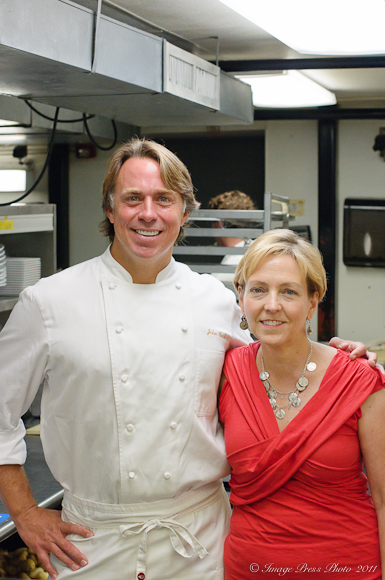
In the kitchen at August with Chef Besh
The foundation also helps to support local farmers by offering them micro loans and mentoring programs with local MBA programs. “Farming needs to be a viable option for families. The cost of farmland is too high. How can family farms make money when land is so expensive? This program offers participants loans with little or no interest. It also provides mentoring to farmers that understand the craft, but may not have the business sense they need.”
Besh believes that food is “the common thread that brings the most unlikely people together. We all want the same thing, to bring great food to the marketplace. Television and the internet has allowed this to happen, raising awareness. Look at all the towns that have Farmers’ Markets now. Twenty years ago it was a struggle. However, we are still losing traction with two thirds of the population (in getting healthier foods to them).”
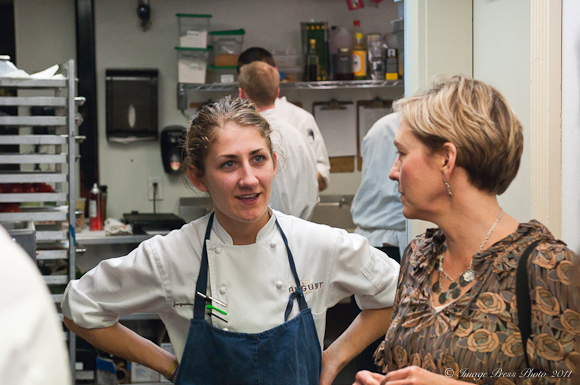
We met Chef Jackie from August when we were there in February. She is incredibly talented.
The philanthropic work that John Besh is involved in is incredibly important to him and should be important to all of us that appreciate the role of food in community. A portion of the proceeds from his first book, My New Orleans, go to Café Reconcile, a program that helps provide at-risk youth an opportunity to learn the necessary skills to enter the restaurant and hospitality industry. He describes this book: “It’s not about my city. It’s all about my story of my town through starry eyes when I grew up and would dress up to come to the city.”
His latest book, My Family Table: A Passionate Plea for Home Cooking, (which will be released November 1st), will also help to support another program Besh believes in, Café Hope. Café Hope is a restaurant that works with at-risk youth to create a a way to become self-sufficient through job training. My Family Table “is about the communal aspects of cooking and dining. The further we get away from the table, the more we lose the recipes and the traditions. Families used to pass down recipes, not chefs trained in culinary school.”
“Families passing down recipes creates the culture and cuisine through the years. Now, families are stocking their pantries with processed foods. We need to pay homage to lessons learned around the table; not just cooking together, but the act of breaking bread.”
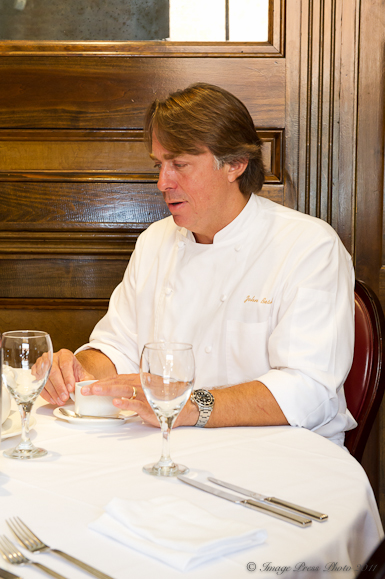
Besh not only invests in the future of those he does not know through his philanthropy, he is also a firm believer in investing in the extremely talented people he has working for him, some of them for as long as fifteen years. “It is important to invest in people and learn to give to them and help support their dreams. It brings me satisfaction. The restaurant is a team.” You will notice that Besh’s restaurants do not brandish his name but rather reflect the people and places important to him and his past.
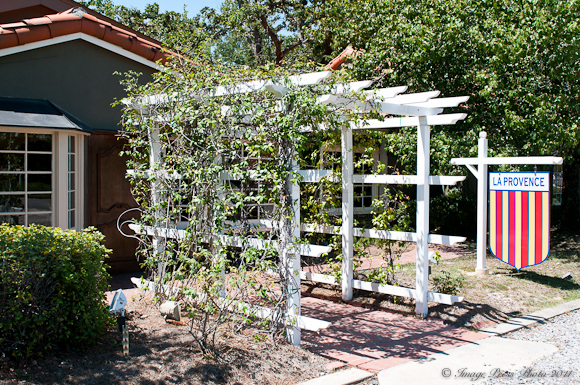
Chef Besh took over La Provence in 2006, following the death of his mentor, Chris Kerageorgiou
One word that came up quite a bit in our conversation was integrity. While the new media attention on food has been positive, there are also some negatives. “While the Food Network raises awareness, it can be dangerous. Iron Chef is a spectacle and I added to the problem making cooking a spectator sport. People need to get back in the kitchen and roll up their sleeves and cook. We need to cook with integrity.”
Besh believes that while integrity in reporting and reviews wasn’t guaranteed years ago, it was more commonplace because you had an institution you were speaking on behalf of. “We now have this tool (the internet and social media). How do we use it? We are in this 140 character or less place that says we have to label everything. There is sometimes a crassness in the way we write and things are not eloquently written. People sometimes come at it with a predetermined intent to bring someone down. We need to write with integrity.”

Fountain in the courtyard at La Provence
If you have been to New Orleans, you know that the food there is special. Comparable dishes never taste the same anywhere else in the country. “Our food here is what it is because it’s here. It’s not only the ambiance of being in these old buildings and preserved atmosphere.” He compares it to drinking wine on vacation. “It’s like drinking a bottle of Village Côtes du Rhône in this itty bitty village in France (and you thought you found something really wonderful) and then you bring it back (home) and it’s just not the same.”
“Cooking outside of New Orleans does not exist out of eyesight of the city. If you go too far one way, you are in the marshes, if you go too far another way, you are in Mississippi or Creole Country. What we have is best to consume here. Some things don’t travel. Culture should not travel very far.”
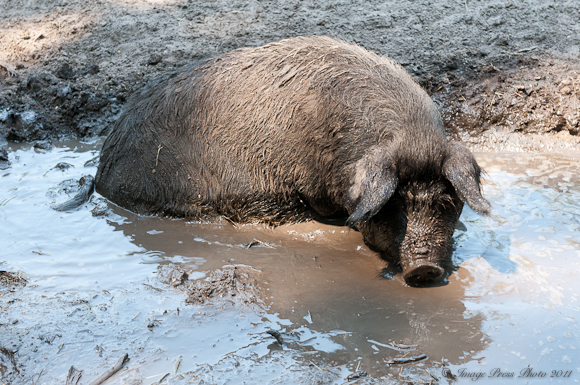
Mangalista Pigs at La Provence
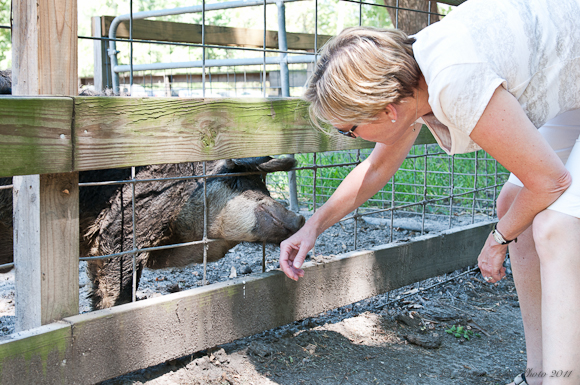
These pigs are also known as Wooly Pigs
In addition to all the restaurants, philanthropic work, television and other special appearances, Chef Besh likes to cook in the kitchen with his chefs as much as possible, but he is particularly hands on at his flagship restaurant, August. Mentored by chefs like Daniel Boulud and Danny Meyer, he knew this life would not be easy. However, this incredibly busy man is finally finding the time to spend more time at home with his family.
“To have this life I’ve always dreamed of having…I am the luckiest guy on Earth. My dreams change. I have seen bad things here with Katrina and in combat. If there is another hurricane, I could lose everything. We need to live for something bigger than ourselves and we have to love it.”
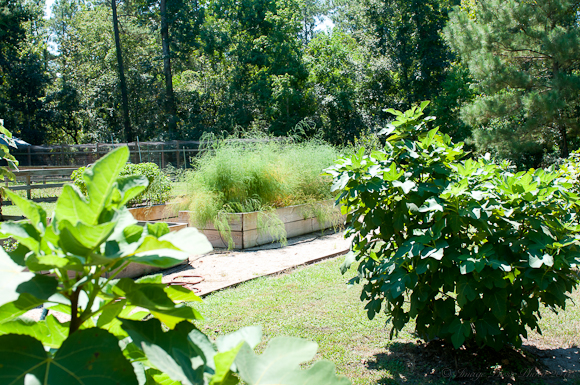
The garden at La Provence
Thank you so much to Chef John Besh for his generosity in taking the time out of his very busy schedule to meet with us. Thank you also to his staff at August for arranging everything for our interview. It was truly a pleasure.
I would also like to thank Chef Erick Loos and the staff at La Provence for the time they spent with us during our visit. Some of the photos in this piece were taken at La Provence, one of Besh’s restaurants, located in Lacombe, Louisiana.
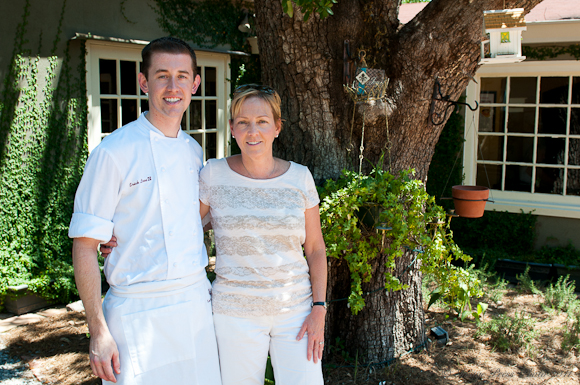
With Chef Erick Loos at La Provence (Chef Loos is also known as The Prince of Porc after winning the 2011 Cochon555!)
We dined at Restaurant August when we were in New Orleans in February and were thrilled to have another opportunity to do so on this trip. It is a very special dining experience and I highly recommend that you put it at the top of your list when traveling to New Orleans.
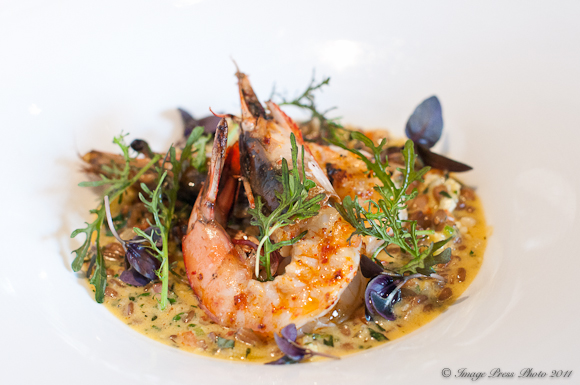
This prawn dish was spectacular at August
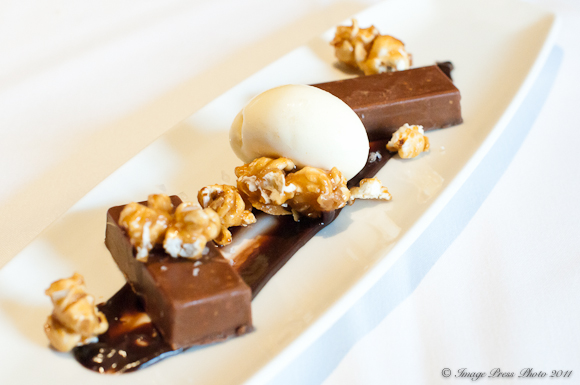
Interpretation of a Snickers Bar with caramel corn and housemade ice cream at August…this was incredible!
Chef Besh’s book, My Family Table, A Passionate Plea for Home Cooking, will be released next week. I was able to preview the book before it’s release. The photographs are beautiful and it is thoughtfully written. It is truly a plea for people to get back into their kitchens and cook for their families. There are suggestions for stocking your pantry with essentials to make cooking at home easier. The book is also full of cooking tips and various techniques. The recipes are perfect for creating the type of communal meals that Besh wants families to have together.
Some of the chapters in the book are aptly named for those of us who cook for our families: School Nights, Breakfast with my Boys, Sunday Supper and Barbecue Wisdom and include many approachable recipes for the home cook. I chose to share this recipe for Pecan-Baked Ham from Chef Besh’s new book since the holidays are right around the corner and baked ham is a favorite of many families during that time of year.
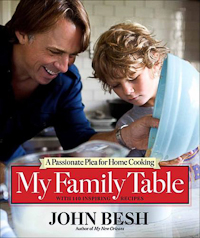
About Chef John Besh
A native of Southern Louisiana, Chef Besh’s long list of accomplishments include six highly acclaimed restaurants (August, Besh Steak, Lüke, La Provence, American Sector and Domenica) that focus on the local foods and traditions of the region. He recently opened Lüke in San Antonio, his first restaurant outside of Louisiana. Besh was named one of Top “10 Best New Chefs in America” by Food & Wine and and his flagship Restaurant August was featured on the late Gourmet magazine’s “Guide to America’s Best Restaurants,” and “America’s Top 50 Restaurants.” He won the James Beard Award for Best Chef – Southeast in 2006, and was awarded Food Arts’ Silver Spoon Award in 2009 for revitalizing the culinary legacy of New Orleans.
Chef Besh is also a frequent guest chef on the NBC Today Show, and has appeared on several shows on the Food Network. His most recent television endeavor is Chef John Besh’s New Orleans, which focuses on cooking New Orleans classics along with some more contemporary dishes, food history, and his personal childhood memories from his beloved New Orleans. Author of My New Orleans and the soon to be released, My Family Table: A Passionate Plea for Home Cooking, Besh is very involved in philanthropic endeavors in his state of Louisiana.
A former U.S. Marine, Besh partnered with Arkel International (emergency reconstruction specialists based in Baton Rouge) to provide high-quality and ready-to-eat meals for thousands of emergency response teams and strategic operations in the United States and around the world. This initiative promotes the Gulf Coast’s food culture as well as the supporting the Louisiana economy. The Louisiana Restaurant Association named him Restaurateur of the Year in 2008 in recognition of Besh’s far-reaching contributions.
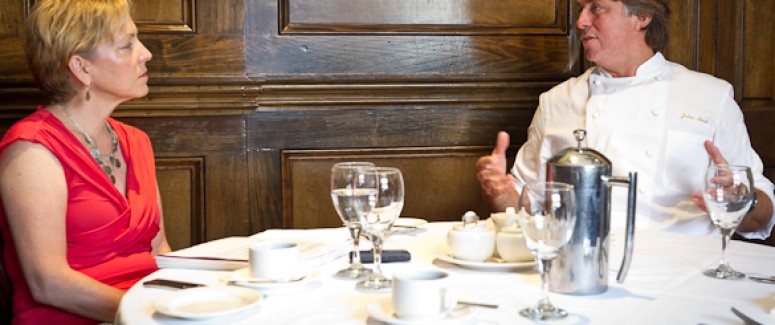
Pecan-Baked Ham
Chances are you won’t find a really good cooked or smoked ham in the supermarket. It’s hard to determine quality by looks alone. All I can say is never use canned ham, and search out a good Italian butcher or ask at your farmers’ market for the best local cooked ham. In the South, we pretty much have pecans coming out of our ears. As a matter of fact, there’s nothing our pigs like more than pecans. We like to coat our hams with pralines, those sweet candies made in New Orleans. But brown sugar and butter will work almost as well if you’re careful to use soft butter and make sure to mix all the ingredients well before you slather the mixture on the ham.
Ingredients:
1/4 cup chopped pecans
1 cup brown sugar
1 tablespoon Chinese five-spice powder
2 tablespoons butter, softened
1 5-pound good quality cooked ham
2 medium onions, chopped
Directions:
1. Preheat the oven to 350˚. In a small bowl, mix the pecans, sugar, and five-spice powder with the butter until you have a fine, crumbly mixture. Rub generously over the ham, patting the crust with your hands.
2. Scatter the onions in the bottom of a heavy roasting pan and add about 2 cups water. Place the ham on the bed of onions. Slide the pan into the oven and roast for about 2 hours, checking to make sure there’s still liquid in the pan. As the water evaporates, add a bit more. The ham is done when a nice glaze forms on the outside.
3. The pecan mixture and the water in the pan will create their own sauce to pour over the ham after you’ve sliced it into beautiful pink rounds. If the sauce seems too thin, just pour into a saucepan and reduce it.
Reprinted with express permission
Chef John Besh
My Family Table: A Passionate Plea for Home Cooking
Andrews McMeel Publishing, LLC